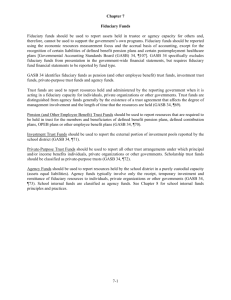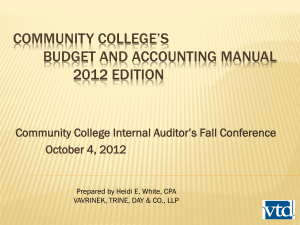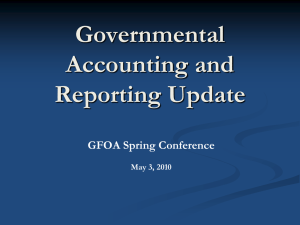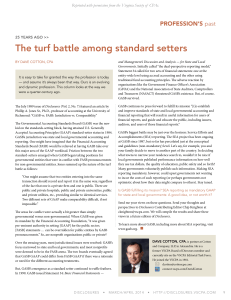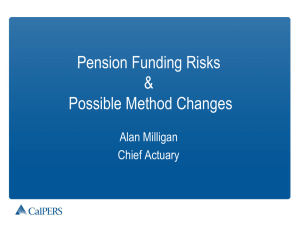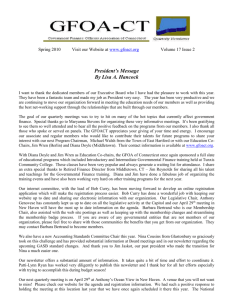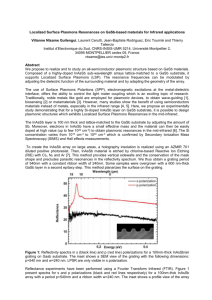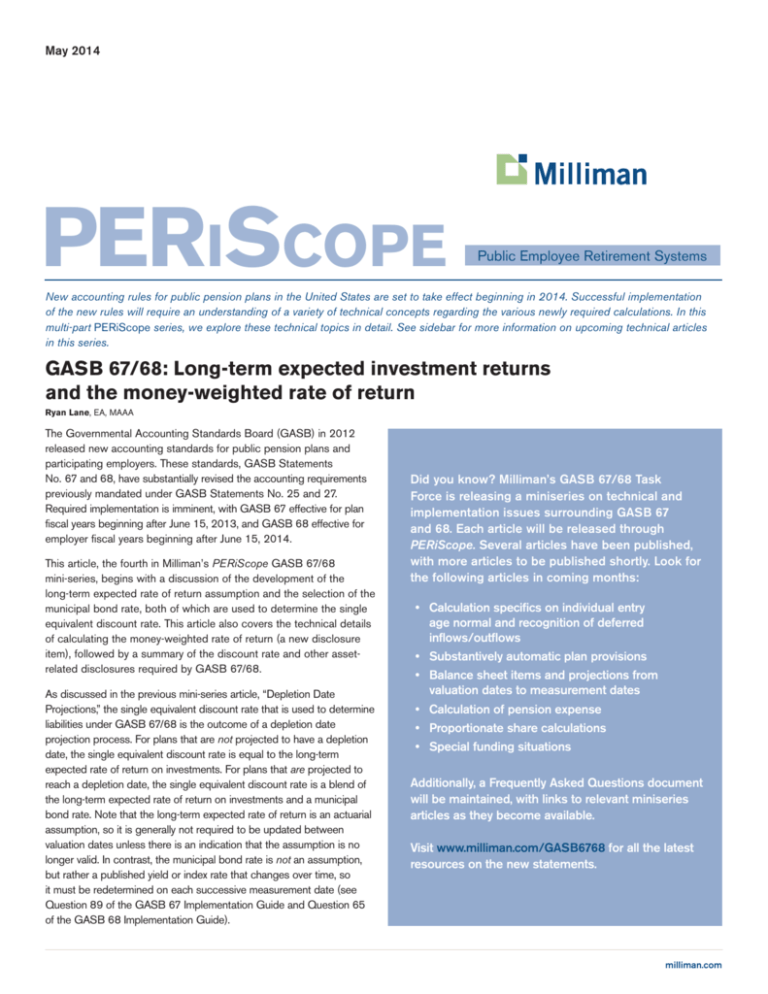
May 2014
PERISCOPE
Public Employee Retirement Systems
New accounting rules for public pension plans in the United States are set to take effect beginning in 2014. Successful implementation
of the new rules will require an understanding of a variety of technical concepts regarding the various newly required calculations. In this
multi-part PERiScope series, we explore these technical topics in detail. See sidebar for more information on upcoming technical articles
in this series.
GASB 67/68: Long-term expected investment returns
and the money-weighted rate of return
Ryan Lane, EA, MAAA
The Governmental Accounting Standards Board (GASB) in 2012
released new accounting standards for public pension plans and
participating employers. These standards, GASB Statements
No. 67 and 68, have substantially revised the accounting requirements
previously mandated under GASB Statements No. 25 and 27.
Required implementation is imminent, with GASB 67 effective for plan
fiscal years beginning after June 15, 2013, and GASB 68 effective for
employer fiscal years beginning after June 15, 2014.
This article, the fourth in Milliman’s PERiScope GASB 67/68
mini-series, begins with a discussion of the development of the
long-term expected rate of return assumption and the selection of the
municipal bond rate, both of which are used to determine the single
equivalent discount rate. This article also covers the technical details
of calculating the money-weighted rate of return (a new disclosure
item), followed by a summary of the discount rate and other assetrelated disclosures required by GASB 67/68.
As discussed in the previous mini-series article, “Depletion Date
Projections,” the single equivalent discount rate that is used to determine
liabilities under GASB 67/68 is the outcome of a depletion date
projection process. For plans that are not projected to have a depletion
date, the single equivalent discount rate is equal to the long-term
expected rate of return on investments. For plans that are projected to
reach a depletion date, the single equivalent discount rate is a blend of
the long-term expected rate of return on investments and a municipal
bond rate. Note that the long-term expected rate of return is an actuarial
assumption, so it is generally not required to be updated between
valuation dates unless there is an indication that the assumption is no
longer valid. In contrast, the municipal bond rate is not an assumption,
but rather a published yield or index rate that changes over time, so
it must be redetermined on each successive measurement date (see
Question 89 of the GASB 67 Implementation Guide and Question 65
of the GASB 68 Implementation Guide).
Did you know? Milliman’s GASB 67/68 Task
Force is releasing a miniseries on technical and
implementation issues surrounding GASB 67
and 68. Each article will be released through
PERiScope. Several articles have been published,
with more articles to be published shortly. Look for
the following articles in coming months:
• Calculation specifics on individual entry
age normal and recognition of deferred inflows/outflows
• Substantively automatic plan provisions
• Balance sheet items and projections from
valuation dates to measurement dates
• Calculation of pension expense
• Proportionate share calculations
• Special funding situations
Additionally, a Frequently Asked Questions document
will be maintained, with links to relevant miniseries
articles as they become available.
Visit www.milliman.com/GASB6768 for all the latest
resources on the new statements.
milliman.com
PERISCOPE
Public Employee Retirement Systems
Long-term expected rate of return assumption
sponsors prepare to implement GASB 67/68, it is an opportune
time to evaluate their own assumption-setting process to ensure
that it complies with the new standards and is well-articulated for
the necessary disclosures. Milliman consultants have the tools and
expertise to work with you and your investment professionals to help
you select a long-term rate of return assumption that will satisfy both
the new ASOP No. 27 and the new GASB 67/68 requirements.
According to GASB Statements No. 67 (paragraph 44) and
No. 68 (paragraph 68), the long-term expected rate of return should
be based on the nature and mix of current and expected plan
investments over a period starting when an employee begins to
provide service to an employer and ending when all benefits to the
employee have been paid. This is likely a much longer time frame
than plan sponsors are used to considering with their investment
professionals. The expected rate of return must be determined net
of investment expenses, but not net of administrative expenses.
Municipal bond yield or index rate
According to GASB 67/68, the municipal bond yield or index rate to be
used for benefit payments expected to be paid after the depletion date is
based on 20-year, tax-exempt, general obligation municipal bonds, with an
average rating of AA/Aa or higher (or equivalent quality on another scale).
GASB 67/68 also specifies that the selection of any assumption
must comply with all applicable Actuarial Standards of Practice
(ASOPs) issued by the Actuarial Standards Board (see paragraph
38 of GASB 67 and paragraphs 23 and 61 of GASB 68).
In September 2013, the Actuarial Standards Board adopted
an updated version of ASOP No. 27, Selection of Economic
Assumptions for Measuring Pension Obligations, which governs
the selection of an investment return assumption and will be
effective for any actuarial work product with a measurement date
on or after September 30, 2014.
While this GASB description provides a basis and some guidance, it
does not state a specific municipal bond rate source that should be
used. For example, Bond Buyer and S&P both publish 20-year municipal
bond indices. The charts below show the rates for each of these indices
since May 2013. Other indices are available as well. If it is likely that a
projected depletion date exists, it will be up to the plan sponsor and
their pension plan professionals to select an appropriate benchmark or
methodology for selecting the municipal bond rate.
The revised ASOP 27 prescribes multiple steps in the assumption-setting
process, including evaluating relevant data, considering factors specific to BondBOND
BuyerBUYER
General
Obligation
20-Bond Municipal
Index BOND INDEX
GENERAL
OBLIGATION
20-BOND Bond
MUNICIPAL
the measurement, and then selecting a reasonable assumption. For this
6
purpose, the term “reasonable assumption” has a specific meaning:
Is appropriate for the purpose of the measurement.
5
Reflects the actuary’s professional judgment.
Takes into account historical and current economic data that is
relevant as of the measurement date.
4
Reflects the actuary’s estimate of future experience, the actuary’s
observation of estimates inherent in market data, or a combination of
the two.
3
5/9/2013
Has no significant bias (i.e., it is not significantly optimistic
or pessimistic).
6/6/2013
7/4/2013
8/1/2013
9/5/2013 10/3/2013
11/7/2013 12/5/2013 1/2/2014
2/6/2014
3/6/2014
4/3/2014
5/8/2014
Source: http://research.stlouisfed.org/fred2/series/WSLB20/
S&P
Municipal
BondBOND
20 Year
Rate Index
S&P
MUNICIPAL
20 High
YEARGrade
HIGH GRADE
RATE INDEX
In selecting the assumption, the actuary may incorporate the views of
experts (i.e., investment advisors, economists, or other professionals),
so long as the resulting assumption reflects the actuary’s professional
judgment. The actuary should not assume that superior or inferior returns
will be achieved, net of investment expenses, from the use of an active
rather than passive investment management strategy (often referred to
as “alpha”), unless there is relevant data supporting this conclusion. All
economic assumptions should be internally consistent, and the rationale
used in selecting any non-prescribed assumption must be disclosed.
6
5
4
In addition to explicitly tying the assumption selection process to
actuarial standards of practice, the new GASB statements require a
description of how the investment return assumption is determined,
as well as disclosure of specific components of this assumption
(see below for a discussion of the additional disclosures). As plan
MAY 2014
3
5/13/13 6/3/13
7/1/13
8/1/13
9/3/13
10/1/13
11/1/13
12/2/13
1/2/14
2/3/14
Source: S&P Dow Jones Indices LLC.
http://us.spindices.com/indices/fixed-income/sp-municipal-bond-20-year-high-grade-rate-index
2
3/3/14
4/1/14
5/5/14
PERISCOPE
Public Employee Retirement Systems
Money-weighted rate of return calculation
One of the new GASB Statement No. 67 disclosure requirements
is the annual money-weighted rate of return. This figure incorporates
both the size and the timing of cash flows to determine an internal
rate of return. The money-weighted rate of return considers the
changing amounts actually invested during a period and weights the
amount of pension plan investments by the proportion of time they
are available to earn a return during that period. There are several
specific requirements for how the rate should be determined:
The rate should be net of investment expenses but not net of
administrative expenses.
The external cash flows (i.e., contributions, benefit payments,
and administrative expenses) used as inputs to the calculation
should be determined on a monthly basis, or more frequent than
monthly if possible.
The cash flows should be determined on an accrual basis of
accounting rather than a cash basis.
Cash-flow weighting should be representative of the plan’s actual
external cash-flow timing (i.e., beginning, middle, or end of month).
From a practical standpoint, plan sponsors may not currently have
access to monthly cash-flow information aggregated across all plan
investments, and may therefore need to build out the infrastructure
needed to enable this information to be compiled. It seems unlikely
that many plans will want to spend the resources required to gather
and report cash-flow information on a daily or weekly basis.
Discount rate and other
asset-related disclosure requirements
GASB Statements No. 67 and No. 68 introduce several new
discount rate and other asset-related disclosure requirements. Many
of these new requirements are contained in both GASB 67 and
GASB 68, and the precise location of the disclosure requirements
between plans and employers can vary depending on the plan type
(i.e., single employer versus agent multiple employer).
To satisfy GASB 67/68, the following information regarding the
discount rate should be disclosed:
Discount rate – The rate applied in the measurement of the total
pension liability (TPL) and the change from the prior measurement date.
Projected cash flows – Assumptions regarding the projected cash
flows into and out of the pension plan, such as contributions from
employers, non-employer contributing entities, and employees.
Long-term rate of return assumption – Include a brief description
of the significant methods and assumptions used to determine the
long-term expected rate of return assumption. This includes the
assumed asset allocation of the pension plan’s portfolio, the longterm real rate of return for each major asset class, and whether the
information is presented as arithmetic or geometric means.
Municipal bond yield or index rate – If the municipal bond yield
or index rate was used in the determination of the single
equivalent discount rate, the rate used and the source of the rate
must be disclosed.
Projected benefit payments – Disclose which periods used the
long-term expected rate of return assumption and which periods
used the municipal bond rate.
Sensitivity of the NPL – Show the net pension liability (NPL)
calculation using a discount rate that is 1% higher and 1% lower
than the single equivalent discount rate.
To satisfy GASB 67/68, the following asset-related disclosure
requirements apply:
Investment policies – The procedures and authority for amending
the investment policy, policies pertaining to investment policy asset
allocation, and a description of changes to the investment policy
during the reporting period must be disclosed.
Fair value of investments and assets of 5% or more – Must
include a brief description of how the fair value of investments is
determined, including any methods and significant assumptions
used if it is estimated and investments in any one organization (other
than U.S. government-issued or -guaranteed) representing 5% or
more of the plan’s fiduciary net position must be disclosed.
Money-weighted rate of return calculation – The internal rate
of return on pension plan investments must be disclosed. As
discussed above, this calculation is done on a monthly, accrual
basis and is net of investment expenses.
GASB Statements No. 67 and No. 68 will require plan sponsors
to consider several elements of their assumption-setting and
reporting process. Now is the time that plan sponsors should
start reviewing the methodology used to set the long-term
expected rate of return assumption, consider which municipal
bond yield or index rate to use as a benchmark, and begin
assessing their ability to obtain monthly cash-flow information
on an accrual basis for the money-weighted rate of return
calculation. Milliman consultants can work with you and your
other plan professionals to help provide a smooth transition to
the new discount rate and asset-related reporting and disclosure
requirements of GASB 67/68.
Ryan Lane, EA, MAAA, is a consulting actuary with the Portland, Oregon, office
of Milliman. Contact him at ryan.lane@milliman.com.
This publication is intended to provide information and analysis of a general nature. Application to specific circumstances should rely on separate professional
guidance. Inquiries may be directed to: periscope@milliman.com.
MAY 2014
Copyright © 2014 Milliman, Inc. All rights reserved.

